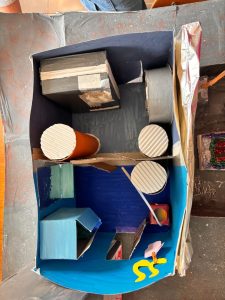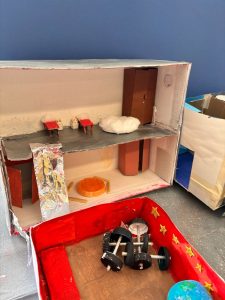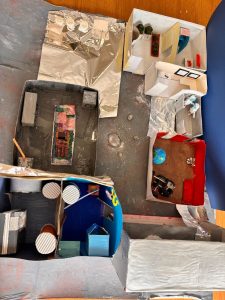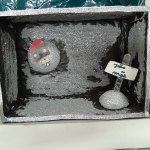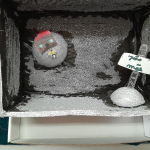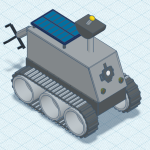MOON… A NEW HOUSE by Classe 2^A
Scuola secondaria primo grado Sabin Monza-Monza e della Brianza Italy 12 years old 18 / 12 Italian Moon
Project description
La nostra squadra di esploratori ha scelto la posizione della Luna per progettare una base spaziale in grado di superare importanti sfide per consentire agli astronauti di rimanerci per lungo tempo.
Abbiamo creato un plastico con materiali di riciclo come cartone, carta giornali, scatole e tempere.
Il lavoro ha previsto diverse fasi di studio, divisione in gruppo di esperti da due e tre persone e realizzazione del plastico.
Per primi il gruppo suolo ha costruito una base con crateri per simulare il suolo della Luna.
Successivamente il gruppo architettura ha scelto il layout delle unità abitative. Sono state utilizzate scatole di diversa misura con diverse destinazione d’uso: zona cucina, zona serra, zona rifiuti, zona giorno, zona notte, zona bagni, zona abbigliamento, zona gym, zona controlli medici, zona laboratorio e comunicazioni.
Il locale cucina è costituito da un piano di lavoro, posto al centro della stanza, adibito alla preparazione dei pasti: per re-idratarli e assemblarli, adibito anche a piano di cottura. La maggior parte del cibo spaziale è contenuto in scatole o lattine oppure sigillato a vuoto in buste di plastica o alluminio. I cibi liofilizzati vengono inseriti in un’apposita macchina per la reidratazione.
Vi è un frigorifero che serve per conservare gli alimenti a lungo, così da non utilizzare il solito cibo in lattina o disidratato. Un frigorifero operativo a gravità zero e capovolto, dalle dimensioni di un forno a microonde. Vi è uno scaldatore a microonde, al cui interno vengono messe le buste o le scatolette del cibo che si vogliono riscaldare.
Vi è un sistema per recuperare l’acqua e renderla potabile: prevede il recupero del vapore acqueo del respiro, dell’urina e del sudore degli astronauti. Si utilizzano delle apposite cannucce grazie alle quali vengono consumati l’acqua e i succhi di frutta.
Nella zona cucina manca il lavandino perché sulla Luna l’acqua è assente allo stato liquido.
Le pareti e il pavimento sono di cartone, dipinti esternamente ed internamente con la tempera grigia. Tutto l’arredo è stato costruito con piccole scatole di cartone, dipinto poi con la tempera. Ci sono delle cannucce (collegate al sistema di recupero dell’acqua) e delle piccole buste in plastica (cibo sottovuoto).
Nel locale serra sono state inserite diverse varietà di piante con un reattore per la produzione d’ossigeno e una lunga terriera per lattughe.
Il locale gestione rifiuti è così strutturato: dalla porta d’ingresso si può osservare, sulla sinistra, un macchinario predisposto per il riciclo dei rifiuti liquidi. Il contenitore che raccoglie i rifiuti liquidi, e che è collegato al macchinario, è a sua volta collegato a un contenitore rifiuti liquidi posto nel locale accanto, il bagno. I due contenitori sono collegati tra loro grazie a tubi di aspirazione posti sotto il pavimento. Nell’altra parte della stanza, invece, c’è un apposito serbatoio disposto per raccogliere i rifiuti solidi. I rifiuti solidi vengono poi imballati e sigillati da un macchinario, posto accanto, che sigilla i rifiuti in sacchi di plastica. Questi sacchi saranno poi caricati su un razzo che sarà inviato sulla Terra e si autodistruggerà a contatto con l’atmosfera.
Dal locale rifiuti si può accedere al locale bagno, grazie ad una porta.
Il locale zona giorno è arredato in modo molto semplice: al centro del locale si trova un tavolo rotondo con attorno delle panche dove gli astronauti possono trovarsi per creare un ambiente più familiare. Ai lati della stanza ci sono due scaffalature, dotate di ante, che permettono agli astronauti di inserire all’interno tutte le strumentazioni necessarie per svolgere gli esperimenti. Su un lato è stata realizzata una grande cassapanca, utilizzabile anch’essa come contenitore.
Al piano superiore della zona giorno è posta la zona notte. Vi sono due letti, due comodini, un armadio e un tappeto. Per creare i letti abbiamo utilizzato dei bastoncini di legno come base, gomma piuma per fare le coperte e del cotone idrofilo per fare il cuscino. Per creare i comodini abbiamo utilizzato della carta e per la sveglia del polistirolo con sopra scritto l’orario. Per creare l’armadio del cartoncino colorato marrone e dello scotch di carta. Per il tappeto del cotone idrofilo e della gomma piuma.
Il locale bagno è così strutturato: accanto al serbatoio rifiuti liquidi è situato il water. Il water è un contenitore con un tubo che aspira l’urina per riciclarla e inviarla al serbatoio rifiuti liquidi posto accanto. A sua volta, per mezzo di una tubatura posta sotto il pavimento, il serbatoio del bagno è collegato al serbatoio, sempre dei rifiuti liquidi, che si trova nel locale gestione rifiuti, per essere riciclato definitivamente. A lato del water ci sono dei ganci che servono per appendere le sacche d’acqua e gli asciugamani. Sul lato opposto si trova uno specchio con mensola e un mobiletto contenente la scorta delle sacche d’acqua e le buste per l’igiene personale.
Nell’arredo manca il lavandino perché sulla Luna l’acqua è totalmente assente allo stato liquido. Dal locale bagno si può accedere, grazie ad una porta, al locale gestione rifiuti.
Le pareti del bagno sono di cartone, dipinto con tempera azzurra, mentre il pavimento, sempre di cartone, è dipinto con tempera di colore blu.
Tutto l’arredo è interamente costruito con cartoncino, lo specchio è stato realizzato con carta stagnola, l’imbottitura delle sacche d’acqua è stata realizzata con cotone idrofilo.
Nel locale laboratorio è stato realizzato un frigo con tavolo per esperimenti, scaffale, boccette per esperimenti e un barile per il tossico.
Abbiamo predisposto anche delle tute spaziali per proteggerci dalle radiazioni e avventurarci nel suolo lunare. Il locale abbigliamento è collocato accanto al locale GYM.
Per facilitare le comunicazioni abbiamo costruito il primo satellite in orbita attorno alla Luna.
Project link
https://www.canva.com/design/DAGCxRu9pXs/FZtQZtHAJVuxFchxFK-CEw/watch?utm_content=DAGCxRu9pXs&utm_campaign=designshare&utm_medium=link&utm_source=editor
English translation
Our team of explorers chose the location of the Moon to design a space base capable of overcoming major challenges to allow astronauts to stay there for a long time.
We created a model with recycled materials such as cardboard, newspaper, boxes and tempera.
The work involved various phases of study, division into groups of experts of two and three people and creation of the model.
The soil group was the first to build a base with craters to simulate the soil of the Moon.
Subsequently the architecture group chose the layout of the housing units. Boxes of different sizes with different intended uses were used: kitchen area, greenhouse area, waste area, living area, sleeping area, bathroom area, clothing area, gym area, medical check-up area, laboratory and communications area.
The kitchen area consists of a work surface, placed in the center of the room, used for preparing meals: for re-hydrating and assembling them, also used as a hob. Most space food comes in boxes or cans or vacuum-sealed in plastic or foil bags. The freeze-dried foods are placed in a special rehydration machine.
There is a refrigerator which is used to store food for a long time, so as not to use the usual canned or dehydrated food. An inverted, zero-gravity operating refrigerator the size of a microwave oven. There is a microwave heater, inside which the bags or cans of food that you want to heat are placed.
There is a system to recover water and make it drinkable: it involves the recovery of water vapor from the astronauts’ breath, urine and sweat. Special straws are used through which water and fruit juices are consumed.
There is no sink in the kitchen area because there is no liquid water on the Moon.
The walls and floor are made of cardboard, painted externally and internally with gray tempera. All the furniture was built with small cardboard boxes, then painted with tempera. There are some straws (connected to the water recovery system) and small plastic bags (vacuum-packed food).
Different varieties of plants have been inserted in the greenhouse room with a reactor for the production of oxygen and a long lettuce trellis.
The waste management room is structured as follows: from the entrance door you can see, on the left, a machine set up for the recycling of liquid waste. The container that collects liquid waste, and which is connected to the machine, is in turn connected to a liquid waste container located in the next room, the bathroom. The two containers are connected to each other thanks to suction pipes placed under the floor. In the other part of the room, however, there is a special tank arranged to collect solid waste. The solid waste is then packaged and sealed by a machine, located nearby, which seals the waste in plastic bags. These bags will then be loaded onto a rocket which will be sent to Earth and will self-destruct upon contact with the atmosphere.
From the waste room you can access the bathroom, thanks to a door.
The living area is furnished in a very simple way: in the center of the room there is a round table with benches around it where the astronauts can meet to create a more familiar environment. On the sides of the room there are two shelves, equipped with doors, which allow the astronauts to insert all the instruments necessary to carry out the experiments. On one side a large chest has been created, which can also be used as a container.
The sleeping area is located on the upper floor of the living area. There are two beds, two bedside tables, a wardrobe and a carpet. To create the beds we used wooden sticks as a base, foam to make the blankets and hydrophilic cotton to make the pillow. To create the bedside tables we used paper and for the alarm clock polystyrene with the time written on it. To create the wardrobe, use brown colored cardboard and scotch tape. For the carpet of cotton wool and foam.
The bathroom is structured as follows: the toilet is located next to the liquid waste tank. The toilet is a container with a tube that sucks in urine to recycle it and send it to the liquid waste tank located next to it. In turn, by means of a pipe placed under the floor, the bathroom tank is connected to the liquid waste tank, which is located in the waste management room, to be permanently recycled. On the side of the toilet there are hooks used to hang water bags and towels. On the opposite side there is a mirror with shelf and a cabinet containing a supply of water bags and personal hygiene bags.
The sink is missing from the furnishings
#Arts & Crafts
Other Projects
Habitat on Saturn’s moons
Estado de México – Mexico
Rover lunar basados en la biónica José Muñoz 5B



